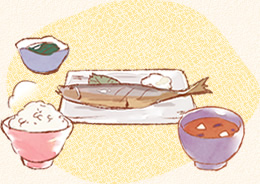
When one hears the term "miso soup," the mind is immediately drawn to thoughts of breakfast, of the flavor that is the cornerstone of the traditional Japanese-style meal. However, this style of miso soup, derived from bean paste – where did it come from? Perhaps surprisingly, there is no clear consensus on its origin. It is currently thought that even as early as the Nara Period, the method for making miso soup had been passed down from Ancient China. Within a document known as the Taiho Code, which first appeared early in the Nara Period in the year 701, there is a passage pertaining to an ancestor of modern soy sauce, called hishio, as well as a "not-sauce," which is referred to as misau or mishou. It is believed that this mishou is the genesis of the modern miso.
In addition, there is one source that gives us reason to believe that miso was being used even prior to the Nara Period. When hishio was first exported from Ancient China, it went via the kingdom of Goguryeo on the Korean Peninsula. In this context, it became known as Goryeo sauce (koma bishio). However there is also a record of a second food being shipped alongside the koma bishio. This was labeled as mitsuso. Could this mitsuso truly be the same thing as pre-modern Japan's mishou? That they are one and the same is still a somewhat controversial hypothesis, however at any rate, it seems almost certain that by that time, both hishio and mishou were in widespread domestic use within Japan.
That being said, it is difficult for us to say with any certainty what the true origin of miso is. However, the Japanese people were very quick to adopt its flavor. Within the former capital city of Kyoto, there are store records of mishou being sold that date back even as far as the Heian Period. Furthermore, in the Kamakura Period, there are records of the processing of soybeans at various Zen Buddhist temples. The currently prevailing theory states that this is likely the origin of what we now know as miso.
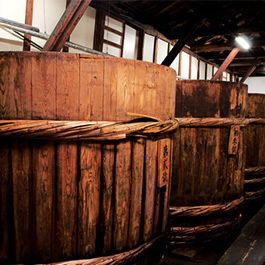
Despite the mystery of its origin, miso is securely fixed in the Japanese consciousness. By the Muromachi Period, it had become completely assimilated into the day-to-day lives of ordinary people. It was in this period that the miso soup which was to become the almost singular image of miso's culinary usage began to appear. Moreover, following the demise of the Muromachi Shogunate and the rise of the Warring States Period, local warlords found miso to be a convenient method of feeding their foot soldiers and noncommissioned officers. This in turn encouraged massive developments in regions' ability to produce miso. So when you encounter a modern businessman drinking miso soup in the workplace, remember that it all began with the warriors of the past, drinking miso before heading into battle. It is a fascinating thing that, in some ways, our approach to miso's power has hardly changed at all, from the distant past to the present day.
It should also be noted that, regarding this miso born out of the Warring States Period, two varieties stand out as particularly notable: Takeda's Jinya Miso and Uesugi's Echigo Miso. Takeda and Uesugi…? When one hears these names, naturally what comes to mind are the great figures of Takeda Shingen and Uesugi Kenshin, the legendary rival generals of the Warring States Period. Without a doubt, these great leaders would have had a keen interest in the diets of their soldiers. They were fully aware of the importance of food in battle, and it is perhaps in this respect that the modern businessman with his cup of miso soup seeks to emulate the heroes of the past.
Although it was the tumultuous Warring States Period that pushed miso production to expand and diversify, with the dawn of the Edo Period and the return of political stability, "miso culture" as a phenomenon truly took off. With the rise of Edo as the capital of the new Tokugawa Shogunate, the city itself saw a rapid population expansion, which naturally led to the gradual appearance of more shops selling miso. By the final years of the Edo Period, these shops would number between 500 and 600. In addition, there were specialty shops known as Misoya which, as the name suggests, sold the same type of goods, which led to an atmosphere of intense competition within the city. In this environment, a shop owner had to be quick-witted in order to thrive, or else his business would soon be nothing but a memory.
◇
Fortunately for Edo's economy, with the Shogun's implementation of the policy of sankinkotai, requiring Daimyo to spend a significant amount of time living in the capital, Edo became a place where people from all over Japan gathered. Of course, this also led to the introduction of different local diets, as the safety and stability offered by the Shogunate allowed the transportation of products between different regions to once again become possible, leading to Edo becoming not only a meeting place of various people, but also of various goods. This new influx of people and products from around the country was a boon to the merchants of Edo, who suddenly had the ability to sell a man food from his native province – to recreate the tastes of home, even while far away in the Shogun's capital.
◇
The servants and samurai who accompanied their lords on the mandated trips to Edo certainly did come to miss the familiar flavors of home, and once they found that those flavors could indeed be obtained in Edo, the shops who sold these tastes to them were sure to have repeat customers. Beyond that, shops such as these also piqued the curiosity of Edo locals, who having seen the arrivals of people from various parts of Japan, were now intrigued to try the different foods they brought with them as well. Thus Edo became the stage for an explosion in variations on the traditional flavor of miso. Today, if you look in the miso section of a supermarket, you can see many different varieties of miso descended from this foundation.
However, even though today we have an abundance of miso varieties available, the fact remains that during the Edo Period, that variety was even richer. This is largely due to the fact that, as Japan entered the Meiji Period, despite the process for making miso becoming more advanced, popular taste in miso became more uniform. If you think about it, this makes sense, as industrialization is all about streamlining production and cutting down costs. In order to more easily facilitate mass production, consolidating the product range is a reasonable first step. As it so happened, this move toward consolidation came at a time when Japan was, above all else, striving for modernization, so as to be able to stand shoulder-to-shoulder with the Western powers of the era. Given that type of socio-economic atmosphere, it is quite easy to imagine how the trend of the time became "quantity" over "quality." So then, this was the ultimate fate of the Misoya of Old Edo, who sold the miso that was the nation's pride. They are an image we no longer know in the modern world, and yet remain an evocative scene in the imagination.
As was introduced in the story of soy sauce, during the Kamakura Period a Zen monk known as Kakushin, who had been studying in China, returned to Japan, bearing with him the Kinzanji Temple method of preparing miso and thus allowing the start of the production of soy sauce. "But," you may ask, "aren't we discussing miso, not soy sauce?" Indeed, this is not an unreasonable question, and you are, of course, correct. What Kakushin brought back to Japan was indeed a miso recipe, however it was as a direct result of this that soy sauce manufacturing was able to begin.(※) More relevantly to our current topic, however, this Okeyozan Temple Miso did not end up becoming a major player in Japan, as the Japanese had already found miso whose flavor more suited their tastes. This is not to say that Kakushin had no sense of taste himself, though, for as a matter of fact even today, Kinzanji Miso is still made using the recipe he carried back. The kanji reading, though, while retaining the same pronunciation, has been changed from 経山寺味噌 to 金山時味噌. It enjoys a strong following today as a side dish. However the miso commonly used in day-to-day cooking, assumedly, couldn't become a main dish in and of itself.
◇
※ For further information, please visit "The Story of Soy Sauce," also on this site.
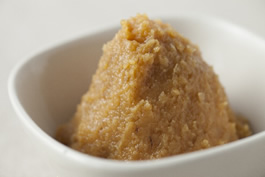
As seasonings, both soy sauce and miso have the same ancestral roots. That said, nowadays the many variations of miso outnumber those of soy sauce. However at the same time, it could be argued that the actual taste of these different miso variations is in fact less diverse – in other words, that miso is perhaps not as fully developed as other seasonings.
◇
Try to imagine the sales floor of some shop. In the case of soy sauce, koikuchi, or "strong soy," has been and continues to be the standard, as is thus the most produced and the most commonly stocked by stores. And yet in contrast, if we look to the miso section, there is a vast variety always on offer – this is the key difference.
In the past, both miso and soy sauce would have been homemade, and therefore every family would have their own unique style and taste. However with the advent of industrialization, the soy sauce companies modernized more rapidly than those producing miso, and thus, in order to make production cheaper and more efficient, the product ranges were made smaller, focusing on the most popular varieties. Miso producers, in contrast, had, even as early as the Edo Period, implemented a system relying on small, local producers. This allowed the preservation of a multitude of regional tastes, which were an outgrowth of the old family recipes. This uniqueness of production methodology is a large factor in the difference between modern miso and modern soy sauce, the currently established flavor of which is in fact a product of the simplification of varieties that accompanied its industrialization. This is a stark contrast to the many varieties of miso, the majority of which are largely the same as when they were being produced by individual families hundreds of years ago.
◇
An important factor in this is also the relative ease of production by hand of miso as compared to soy sauce. Soy sauce was, of course, also made by hand in the past, however the vast majority of it was simply a standard style. This style is now referred to as tamari and is separate from what is now considered standard "table soy sauce." However when compared to the process for handmade miso, tamari is much more time and labor intensive.
There is also one more reason why miso outlasted soy sauce as a handmade product, and that relates to its use at mealtimes. While soy sauce could be used with effectively any food and at any meal, miso remained set aside only for certain side dishes. Soy sauce, as well, is obviously a liquid, whereas miso is a solid. Furthermore, when producing soy sauce, the flavor is the only thing actually extracted from the soybean, while miso, in contrast, is able to preserve many of the nutrients intrinsic to soy.
Given all that, let us think for a moment. Imagine if you will that we have set before us some soy sauce, some miso, and some rice. If you wished to make the rice into a side dish for some larger meal, which would you use to season it, the miso or the soy sauce? Of course, if you were to use the soy sauce, the result would no doubt be perfectly edible, and most likely quite delicious. However in terms of nutritional value, the unanimous winner would have to be the miso. In the past, people made good use to miso's power in their daily lives, despite rarely ever being conscious of the fact that they were doing so. In the case of handmade daily meals, it only makes sense to use more miso. Furthermore, since miso is easier to make, people ultimately chose to buy soy sauce and make miso themselves. There you have it…the same origin, yet two very differents paths of development.

It may come as a bit of a shock, but did you know that miso actually has a deodorizing effect? Or rather, to put it more correctly, it is capable of absorbing various odors. For example, in the case of items such as miso fish, by inserting the miso, it will absorb nearly all the unpleasant odors of the raw fish. This effect is caused by the abundance of soy proteins contained within the miso. For this reason, miso tends to be used with foods that would otherwise have very pungent odors, and is especially common in dishes using fish. Another common example would be oyster hot pot, often cooked during the winter, which takes full advantage of these odor-neutralizing properties of miso.
There is, however, in fact a second half to miso's odor-controlling powers. If the first half was its ability to absorb unwanted smells, the second half is the smell of the miso itself. Naturally, there are some people who are not overly fond of the smell of miso, however with regard to the Japanese, these people are few and far between. It is most commonly described as a faint, savory aroma. However this smell is surprisingly powerful, easily capable of forcing out other smells. As a result, many people enjoy their meals with the pleasant aroma of miso in the air.
Having said that, though, leaving Japan and venturing overseas will lead to a different reception of miso than Japan's impression of appetite-inducing aroma. Miso is, afterall, a fermented product. As a result of this fermentation, it carries a very unique odor. However these days, miso is still being marketed around the world for its stronger personality versus soy sauce. While not bearing quite as strong a stigma as natto, though, in many countries miso's smell is still considered unpleasant, particularly in parts of the United States and Europe. In fact, there have been cases recorded of people such as homestay students being banned from making miso soup, even to the extent, in one rather extreme and absurd case, of being threatened with eviction from an apartment.
On the other hand, on the whole there seems to be no problem with the reception of miso across much of Asia, unsurprisingly. Fermented foods of this nature have for centuries been one of China's great cultural exports, therefore both miso and soy sauce have been widely assimilated into daily life across the majority of Asia, while still retaining the unique characteristics of each product. Then there is, of course, the type of miso soup that is native to Japan. Simply put, no matter where you go in Asia, the scent of fermented soybeans is an implicit part of average daily life.
In the "Versatility of Miso" section, it was mentioned that there is a wide variety of miso that exists. In the simplest terms, it is usually classified as red miso, white miso, or mixed miso, but this is not strictly correct. Even within just red miso, there are different types of raw ingredients used. Therefore, the following is the official JAS standard of classification for types of miso:
-

◇Rice miso – prepared using both rice and soybeans
-
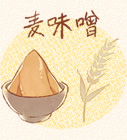
◇Barley miso – prepared using soybeans and barley of the Hordeum vulgare or Hordeum vulgare var. nudum species
-
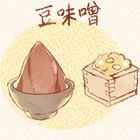
◇Soybean miso – prepared using only soybeans
-
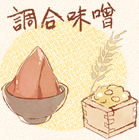
◇Mixed miso – prepared using some mixture of soybeans, barley, rice, or other ingredients or cooking methods
The raw ingredients were chosen as the standard of measurement because they are the most consistently reliable classification. Miso color can vary, depending on how long it has been aged, therefore miso of the same color can be of a completely different makeup, and red or white miso can be made with either identical or differing ingredients. This makes classifying miso purely by color into an untenably difficult experience where it is effectively impossible to conclusively determine one from another, therefore the system based around ingredients was implemented by the JAS as a "last resort" for when all other methods become inconclusive.
Among the types of miso that fall outside the standard "miso," there is a product known as "raw miso." This is not used as a seasoning, but rather as a secondary food. Instead of simmering the miso as would be done for miso soup, it can be eaten in the same manner as a vegetable, often paired with rice. This falls into the "other cooking methods" class in the JAS system. The most famous example of this is the previously mentioned Kinzanji Miso. In addition, the wild miso from near Gifu in Takayama Prefecture, as well as sotetsu miso from Okinawa are both famous examples of local flavors or variations. Also many places use miso to make batter for seafood. This batter miso is, among the types of miso dishes created in Japan, among the closest to the original, ancient miso recipe, and yet is relatively easy to find in shops. Furthermore, since it does not require fermentation, it is one of the easiest varieties for the home chef to attempt making by hand. Of course, anyone can try making normal miso at home as well, it will just require several months of fermentation before it is finished. If you don't feel like taking the time for that, the best thing is to start with a raw miso dish. Recently, many websites have begun to appear with advice on and experiences of hand making miso, so you should try to find the flavor that most suits your own tastes!
- 片山商店
- 糀屋団四郎
- 坂豊商店
- 堀周商店
- 西村糀店
- 百川味噌
- 渡辺益二商店
- 扇弥商店
- 山田醸造
- 竹林味噌
- 田村定吉商店
- 越後味噌醸造
- 鈴木味噌醤油麹店
- 小林醤油店
- 明間味噌醤油店
- 石本商店
- 奈良橋醸造
- 野沢食品工業株式会社
- 石山味噌醤油
- 寺沢麹店
- 村山健次商店
- 峰村醸造
- 又上
- つたや商店
- 幸田こうじ店
- てんや味噌・醤油
Warning: Use of undefined constant miso - assumed 'miso' (this will throw an Error in a future version of PHP) in /home/mbrs/public_html/hakkousyoku/wp-content/themes/hakko/page_miso_e.php on line 211















